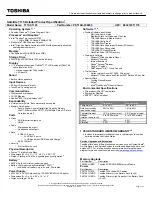
85
Appendix
Glossary
ACPI (Advanced Configuration and Power Management Interface)
Modern standard for reducing power usage in computers.
AUTOEXEC.BAT
AUTOEXEC.BAT is a special-purpose file that is automatically executed by DOS whenever the com-
puter is turned ON or restarted. This file contains important commands that help configure the system
to work with certain software and devices. Windows 95 and later has its own startup files and may not
use or may ignore parts of the AUTOEXEC.BAT file.
BIOS (Basic Input/Output System)
BIOS is a set of routines that affect how the computer transfers data between computer components,
such as memory, disks, and the display adapter. The BIOS instructions are built into the computer’s
read-only memory. BIOS parameters can be configured by the user through the BIOS Setup program.
The BIOS can be updated using the provided utility to copy a new BIOS file into the EEPROM.
Bit (Binary Digit)
Represents the smallest unit of data used by the computer. A bit can have one of two values: 0 or 1.
Boot
Boot means to start the computer operating system by loading it into system memory. When the manual
instructs you to “boot” your system (or computer), it means to turn ON your computer. “Reboot” means
to restart your computer. When using Windows 95 or later, selecting “Restart” from “Start | Shut Down...”
will reboot your computer.
Bus Master IDE
PIO (Programmable I/O) IDE requires that the CPU be involved in IDE access and waiting for me-
chanical events. Bus master IDE transfers data to/from the memory without interrupting the CPU. Bus
master IDE driver and bus master IDE hard disk drives are required to support bus master IDE mode.
Byte (Binary Term)
One byte is a group of eight contiguous bits. A byte is used to represent a single alphanumeric character,
punctuation mark, or other symbol.
Clock Throttling
Chipset function which allows the processor’s clock to be stopped and started at a known duty cycle.
Clock throttling is used for power savings, thermal management, and reducing processing speed.
COM Port
COM is a logical device name used by to designate the computer serial ports. Pointing devices, mo-
dems, and infrared modules can be connected to COM ports. Each COM port is configured to use a
different IRQ and address assignment.
Summary of Contents for L8400B
Page 5: ...5 Italian Portuguese Spanish Swedish ...
Page 13: ...13 SECTION 2 KNOWING THE PARTS Top Side Front Side Left Side Right Side Rear Side ...
Page 22: ...22 2 Knowing the Parts ...
Page 56: ...56 4 Using the Notebook PC ...
Page 94: ...Visit www asus com for updated specifications ...
Page 96: ...Visit www asus com for updated specifications ...












































